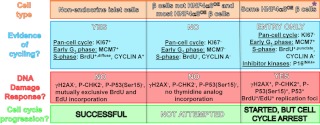Fig. 7.
Cell cycle progression of islet cells can be discerned by the manner of thymidine analog incorporation and multiple marker analysis. Schematic illustrating the cell cycle characteristics of cell types present in an HNF4α8-transduced human adult islet in vitro. Left column, Nonendocrine islet cells successfully turn over, distinguished by proper thymidine incorporation (diffuse), and activation of multiple cell cycle proteins. Middle column, Conversely, human adult β-cells are almost all quiescent and do not attempt cell cycle entry. The majority of HNF4α8-overexpressing cells do not show any attempt at cell cycle entry and progression. Right column, However, some of the HNF4αHigh β-cells are able to initiate cell cycle entry but activate cell cycle arrest programs such as the DNA damage response in an attempt to fix an apparent S-phase insult (exemplified by punctate thymidine analog domains). Asterisk, CyclinD3/Cdk6- and CyclinD3/Cdk6/HNF4α8-overexpressing β-cells fall into the latter category as they do show signs of active cell cycling and DNA damage response. However, the successful ability of these cycling β-cells to halt cell cycle progression upon double stranded DNA damage might vary depending on the cocktail of genes being constitutively overexpressed.

